SATURDAY
DECEMBER 30 - 2017- Chichester Gravel Pits
Ros Norton
reported on today's walk
Today 7 of us met at
North Mundham car park for a walk among the Chichester
Gravel Pits on a sunny and mild windy morning. There
was a lot of wildlife activity at the car park
including robins, blue tits, a green woodpecker,
rooks, long tailed tits and a grey
squirrel.
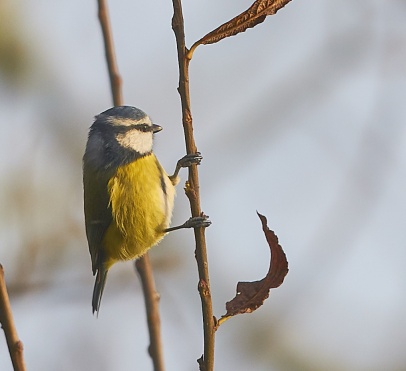
On many of the lakes
were coots and tufted ducks. Other ducks included
gadwall, shoveller, pochard, mallard and teal. There
were several great crested grebes and one little
grebe.
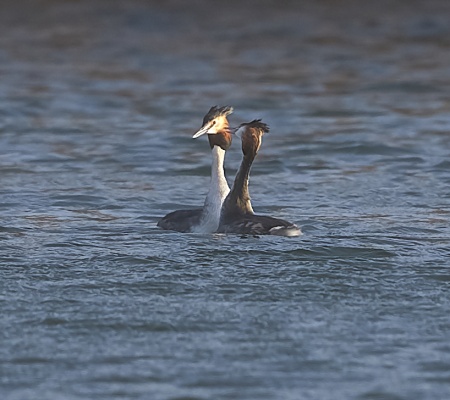
As well as mute swans
there were 4 black swans including 2 juveniles.

A few sightings of a
little egret and one grey heron and both greylag and
Canada geese were seen. There were brief sightings of
goldcrests, kestrel and bullfinch. Wren and dunnock
were heard. There were distant gulls on the lakes.
Just a few plants in flower included winter
heliotrope, daisy, yarrow, white deadnettle, field
speedwell, cow parsley and hogweed. Some pink fruits
on spindle added colour to the hedgerows.
SATURDAY
December 23, 2017 - Langstone
Tony Wootton
reported on the walk by Havant Wildlife
Group
Six of us set off on a
grey damp morning and it stayed a grey damp morning
all morning. Did that bother us? Not a bit, nor did it
bother quite a lot of the birds because they are
obviously pairing up. We saw Mute swan, brent,
shelduck, wigeon,gadwall, teal,mallard,pintail,
shovelor, red breasted merganser, little grebe, great
crested grebe, cormorant, little egret, cattle egret,
grey heron, moorhen, oystercatcher, golden plover,
grey plover, lapwing, dunlin, black tailed godwit,
curlew(63), redshank, greenshank, common sandpiper,
blackheaded gull (1 with black head),common gull,
herring gull, stock dove, woodpigeon, collared dove,
great spotted woodpecker, grey wagtail, pied wagtail,
wren, dunnock, robin, stonechat, blackbird,
songthrush, redwing, chiffchaff, goldcrest,
longtailed, , blue and great tits, jay, magpie,
carrion crow, starling, house sparrow, greenfinch and
by no means last, goldfinch. No raptors.
Finally, to make half of the groups day, a wren with
it's alarm call, alerted us to a weasel.
Merry Xmas and a Happy New Year to
everyone.
SATURDAY
December 16, 2017 - Farlington Marshes
Helen Penfold
reported on today's walk by the Havant Wildlife
Group
Fourteen of us met on
a bright, chilly morning at Farlington. Our walk
started well, being greeted by a charm of goldfinches,
and then seeing 15 avocets on a mudbank in the
channel. As the tide covered the mud, they moved
across to the lake, where we later counted 40 + of
them. There were ducks on the lake, including pintail,
wigeon and teal. A flock of redshank were nestling
together on the mud and two snipe were preening
themselves on the bank.
A bit further on we were delighted to see 20+ bearded
tits, swinging on the reeds, giving us a wonderful
view of them in the bright sunlight. Two reed buntings
were also seen.

A Raven pecked its way
across the field, where there were also plenty of
Brent geese and Canada geese and a solitary white
goose, as well as lapwings and curlews.Looking out
towards Portsmouth we could see many birds on a
mudbank, including shelducks, dunlins, knots, grey
plovers and oystercatchers. Walking eastwards, we saw
shovelers, stonechats, a song thrush in the grass, a
buzzard, a kestrel and a few bar tailed godwits.
As we turned inland towards the hut, we saw many black
tailed godwits, pecking in the grass, and when we were
nearly back at the car park we enjoyed watching a
goldcrest taking a prolonged bath in a muddy puddle,
just in front of us.

Derek also managed to
get a photo of a Rock Pipit (left) and later a Water
Pipit (right),
the latter showing its distinctive white
supercilium.
Other sightings
included egrets, little grebe, rock pipits, two water
pipits, a heron, gadwalls, moorhens, coots, mallards,
a wren, robins and magpies. A water rail was heard by
a few of the group.
SATURDAY
December 9 2017 - Pagham Harbour
Heather Mills
reports on yesterday's walk by the Havant Wildlife
Group. 11 met on a very bright and cold morning at
Pagham Harbour RSPB Reserve.
The group taking
a coffee break (minus Heather the photographer)

We were serenaded with
a fine Robin in the car park and set off in reverse to
our usual route due to the path being blocked off due
to the construction of a new hide overlooking the
lagoon. Many small birds, Blue and Great-tit fed off
the feeders provided, with Chaffinch and House
Sparrows in attendance below. A Song Thrush gave good
views in the Hawthorn above. As we reached the shore
path the usual Redshanks and burbling Curlew called
and could be seen easily. At the viewpoint overlooking
the small inlet from the lagoon Caroline brought our
attention to a Spotted Redshank happily sitting on the
side of the bank with a few Teal. Looking eastwards 6
or so Black-tailed Godwits fed on the mud. Two very
good flocks of approx 100 Wigeon grazed across the
road on the fields to the left of the lagoon and to
the right a large flock of Canada Geese. Apart from 2
Black tails nothing else hereabouts. We moved along
the footpath and came across a Reed Bunting female
avidly feeding which gave us time to scope it for
closer inspection. A pair of Stonechats avidly worked
the thistles on the opposite side of the footpath and
seen again at the end of the walk by most of us. One
lone male Yellowhammer flew past and rested in a tree
some way off and as I called to inform the group some
did manage to get a good view of it. As we proceeded
to the channel inlet we were aware of a strange noise
behind and turned to see a mass of Brent flying over
the centre eastward to the sea.
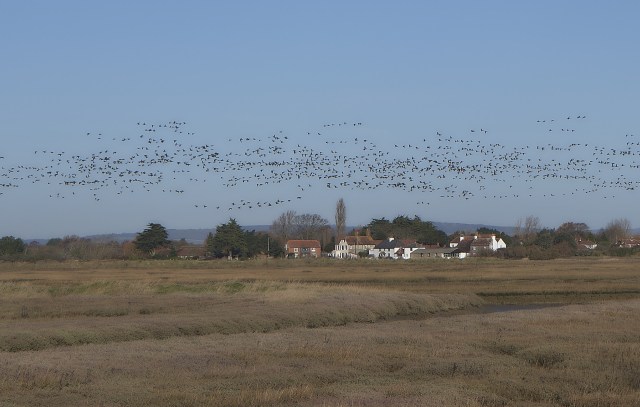
A dozen Avocets with
Shelducks and other waders could be seen far off
resting on the bend of the channel. Having our coffee
break gave a chance to scope for more waders and we
were rewarded with at least 9 Little Grebes in the sea
channel towards Church Norton to where we eventually
ended up walking. Fine views were had of resting
Cormorants far over on the shingle bank and Pintail.
One Curlew came very close feeding in the vegetation.
We all managed to see the differences between the few
Knot and the many Grey Plovers with hundreds of Dunlin
feeding on the mud. An extremely confiding Robin
walked amongst our feet as we made our return. 51
species seen with a calling Chiffchaff in the bushes
at the start of the walk. Flowers seen White dead
nettle and the flowering Gorse.
A very fine morning and we were very fortunate looking
out at today.
SATURDAY
December 2 - 2017 - Forestside
Steph Dale
reported on the walk:
Thank you to the 5 people who turned up in good
spirits on a very grey day for our walk from
Forestside. The wildlife was trying hard to keep
hidden on a fairly cold morning but we did see a
beautiful male bullfinch, fieldfares, redwings, a
mistle thrush, a kestrel, buzzards, lots of robins,
house sparrows, blackbirds, blue tits, starlings,
jackdaws and rooks. We also saw spindleberries,
butcher’s broom, cloudy agaric and King
Alfred’s buns.
There are still a few flowers around – we saw
yarrow, smooth sowthistle, meadow buttercup, hogweed,
bramble and white dead nettle.
SATURDAY
NOVEMBER 18 - 2017 - Pulborough Brooks
Nicola Hammond
reported on today's walk by the Havant Wildlife Group.
"A group of ten met on a crisp but gloriously sunny
morning at RSPB Pulborough Brooks.

The highlights of the
morning were views of both a hen harrier and red kite
from Winpenny Hide, clear views of male bullfinches
from Hanger View and a large flock of whistling wigeon
which flew over us as we walked along. Other birds
seen included a little owl, kestrel, buzzard,
redwings, fieldfares, meadow pipit, lapwings, teal,
pintail, shoveler, mallard, shelduck, Canada geese,
mute swans, black tailed godwit, dunlin, redshank,
heron, common gulls, jackdaws, starlings, pheasant,
pied wagtails, blue and great tits, blackbirds, robins
and dunnock. We also saw a large group of fallow
deer.
Red Kite . . .
Song Thrush
Sadly the hoped for
snipe eluded us so we consoled ourselves at the end of
the walk with hot soup and sandwiches in the
café!"
SATURDAY
NOVEMBER 18 - 2017 - Hayling Oysterbeds
Ros Norton
reported on this morning's walk by the Havant Wildlife
Group
A group of eleven hardy souls met on a drizzly morning
at Hayling Oysterbeds to be greeted by a singing song
thrush heard from the car park. We could see many
birds including brent geese, redshanks, turnstones,
grey plover, pintail, dunlin curlew and a little
egret.
We walked to the Oysterbeds where we saw in the
harbour near a group of roosting oystercatchers, 2
velvet scoters and 5 black necked grebes diving in
Langstone Harbour. In the Oysterbeds was a group of
about 13 red breasted mergansers and a group of 6
little grebes.

We walked further
north and had our coffee break by a seat. Flocks of
dunlin flew over. The rain started to get heavier and
visibility worsened so we could not appreciate the
often spectacular high tide roost at about 11a.m. but
retreated to the car park early.
A few species of wild flowers are still hanging on
including bristly oxtongue, prickly sow thistle,
common mallow, mayweed, ragwort, buttercup and
creeping thistle.
SATURDAY
NOVEMBER 11 - 2017 - Thorney Deeps
Ros Norton
reported on the Havant Wildlife Group walk
On Saturday 11th two people ventured out on an
overcast morning with a little light drizzle at times
and a brisk wind. Parking at Thornham Lane Junction we
walked along a path towards the Deeps (west Side).
Along the path we saw robin, blackbird, wood pigeon
and some goldcrests.
At the little Deeps were many coots and mallards, 2
mute swans, a wigeon and we heard a little grebe. A
heron and egret along the water channel flew away at
our approach, a pair of swans had one large cygnet and
a goldcrest was spotted in a nearby bush.
At the Great Deeps brent geese flew over, two great
crested grebes dived , more herons and egrets seen,
Shelducks, a gathering of cormorants on the far bank,
two very noisy black headed gulls, a greater black
backed gull and some distant ducks entertained us
during a coffee break.
The tide was very low but in the harbour were distant
oystercatchers, curlews , brent geese and redshanks.
We returned via the farm path where a party of long
tailed tits flew along a hedgerow.
Among the flowers seen were bristly ox-tongue, annual
mercury, periwinkle, black knapweed, smooth and
prickly sowthistle, red and white deadnettle, red
clover, gorse, ivy, yarrow, hogweed, wild carrot,
ragwort, meadow and creeping buttercup, periwinkle,
dandelion and daisy.
SATURDAY
NOVEMBER 4 - 2017 - Keyhaven
Tony Wootton
reported this morning's walk by the Havant Wildlife
Group
Just 5 of us set off in the pouring rain this morning,
but boy were we rewarded. We even sat in warm sunshine
eating our lunch.
2 kingfishers, Dartford warbler, 100 yes a 100 curlew
roosting together, at least 60 pintail, a red breasted
merganser and finally a grey phalarope. 55 species in
all.
mute swan, brent, shelduck, wigeon, gadwall, teal,
mallard, pintail, shoveler, Red-breasted Merganser,
pheasant, little grebe, gc grebe, cormorant, little
egret, grey heron, marsh harrier, kestrel, coot,
oystercatcher, grey plover, dunlin, lapwing, snipe,
blacktailed godwit, curlew, redshank, greenshank,
turnstone, black headed gull, lbb gull, gbb gull,
hering gull, wood pigeon, collared dove, kingfisher,
meadow pipit ,rock pipit, pied wagtail, wren, dunnock,
robin, blackbird, cetti's (heard), dartford warbler,
blue tit, magpie, jackdaw, crow, starling, greenfinch,
goldfinch, linnet and reed bunting.
Flowering plants, courtesy of Ros. Common toadflax,
mayweed, red clover, white clover,gorse, dandelion,
purple toadflax, smooth sowthistle, yarrow, hogweed,
cow parsley, ragwort, common mallow, oxeye daisy, wild
carrot, bramble, thrift, creeping buttercup.
(18)
Heather Mills sends a
selection of photos taken by Derek as follows:
Pintail, female Red Breasted Merganser, Grey
Phalarope, female Marsh Harrier and flock of standing
Curlew.

SATURDAY
28 October 2017 - Stansted Forest
Heather Mills
reported on the Havant Wildlife Group walk
9 met this morning on a decidedly Autumnal morning
with low mist in some of the dew laden fields with
bright sunshine leading up to Stansted
House.
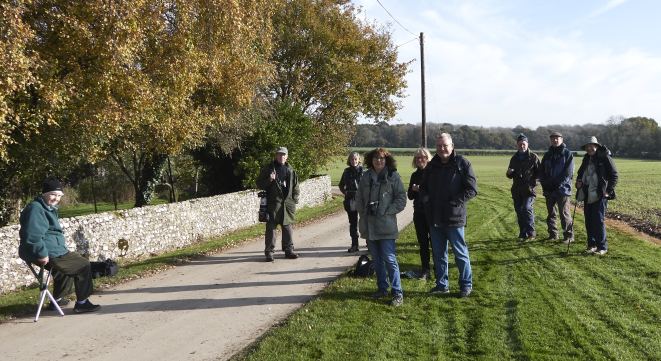
As we took the road on
the eastern side of Stansted, Caroline heard a Raven
call and it appeared in the top field with the cattle
in. The birds were surprisingly quiet until we turned
into the road with the cottages on the corner. We were
dismayed to see a large group of runners from the
South downs all leading dogs, some of which were off
lead. They quickly disappeared leaving us to enjoy the
delights of a group of Yellowhammers in the tree
protectors over the hedge on our left. We thought
there were at least 6. Skylarks were evident and a
lone Roe deer watched us from the middle of the trees
in the adjoining field. The crows, pigeons and
Jackdaws were the most numerous hereabouts.
We were pleasantly surprised as we looked over a gate
northwards, to see 2 male Bullfinch. As we were about
to move off after the delights of the hedgerow birds a
large group of walkers were coming in our direction.
We retraced our steps at Tony's suggestion in case the
Bullfinches had returned. This was our best bit of the
morning as many male and female Blackbirds and a
couple of Song Thrushes with Blue-tits, Jay,
Long-tails gave us good views alighting the field
edge. On our walk at the North eastern edge we were
heading for our coffee break when a small flock of Red
legged partridge appeared in the hedgerow. Some also
saw Goldcrest in the fir trees with a calling
Chiffchaff.
Some of us heard a snippet of Woodlarks but we did not
see them in the surrounding fields this time. 28 birds
species seen or heard.
As we retraced our steps along the main road I spotted
the Parasol fungi that used to be prolific in
the corner with the stunning Sweet Chestnut trees. We
ventured into the woods here but could not locate any
more due to the scrub taking hold.

Ros counted at least
15 plant species in flower but nothing unusual.
Butterflies still about were Red Admiral and Comma.
SATURDAY
7 October 2017 - Chidham
Heather Mills
reports on this morning's walk by the Havant Wildlife
Group at Chidham.
"A decidedly blowy day
at Chidham did not deter 9 of us enjoying the morning.
We took the footpath to the shore and saw a large
flock of Pipits. Also seen with a few Skylarks, one of
which attempted to sing. As we neared the shore a
Greenshank flew up and off over the rising tide. One
of the early highlights was a group of 4 Grey
Partridge hunkering down out of the wind.

Another was a
Bar-tailed Godwit feeding on the tidal edge as we
walked around the lagoon. Some managed to catch the
Kingfisher on the mud bank before it flew off into the
distance. We had a constant companion Rock Pipit
feeding close by, and good views of Curlews and a
Great Blackback Gull. Cormorants resting up along the
shore with a Sandwich Tern fishing as we returned. 36
bird species seen and heard.
4 Roe deer made a
quick dash into the copse as we walked back. We made a
stop to admire Ivy in flower being bombarded by
Hornets.

Some of the flowers
out included Musk and Common Mallow and Sea Lavender
and Sea Aster, Field Speedwell, Self-heal with plenty
of Black Nightshade on the field edge. A good morning
even though we were blown along!"
SATURDAY
30 SEPTEMBER 2017 - Nutbourne
Fay Durant
reported on the Havant Wildlife Group walk
Nine hopefuls met on
an overcast Saturday morning in Farm Lane , Nutbourne
. We walked across the field to the coastal path . In
the field to the right were belted Galloway's grazing
, attractive beasts . Two moorhens were spied with two
fluffy chicks . There was the usual gathering of
sparrows in the bushes. Reaching the shore , Heather
had already spied two wheatears , darting amongst the
rocks and seaweed - very visible to all .
Out at sea were a mass
of wigeon plus a number of Great crested grebe . A
cormorant landed , rather inelegantly , in the water
.Heather saw a turnstone on the spit and a group of
ringed plover , who took off leaving one on its own ,
which might have been injured . There were the usual
gulls , oystercatchers and a curlew . Walking towards
Prinstead , Heather again saw a whinchat , which was a
rarity and good views were had by all .
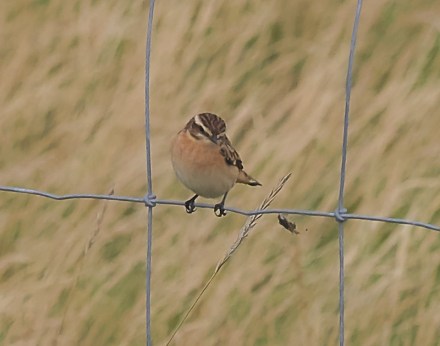
Little egrets were
seen everywhere . A charm of goldfinch rose and
descended on the thistles and teasels . In the
distance two big flocks of geese flew over , one was
definitely Canada geese , the other could possibly
have been Brent .Further on , to the left , on a
narrow spit , a possible whimbrel was seen . A couple
of pied wagtails flew up from the sea wall .It was
nice to meet up with Caroline near the coffee stop at
Prinstead . We returned via the fields and old
orchards , following the footpath that goes off to the
left . Very little was seen , a hovering kestrel . As
rain drops descended , the group made haste back to
the cars .No unusual flowers were seen , a nice show
of common mallow , plenty of bristly oxtongue ,
sowthistle , fleabane , hogweed , yarrow , hedge
parsley , white dead nettle , mayweed and red clover
.A shortened walk but , nevertheless , very rewarding
.
SATURDAY
23 SEPTEMBER 2017 - Medmerry Reserve
Tony Wootton
reported on this morning's walk by the Havant Wildlife
Group
Lovely morning which
just got warmer and warmer with plenty of clothes
being stripped off by the finish. We need to check the
accuracy of the grid reference for the future. Overall
a very pleasant mornings walk. We saw red admiral,
large white butterflies and common darters.
Birds included mute swan, canada geese, brent geese,
gadwall, teal, mallard, pintail, tufted duck,
cormorant, little egret, grey heron, sparrowhawk,
kestrel, coot, lapwing, common sandpiper, BH gull,
herring gull, wood pigeon, sky lark, swallow, meadow
pipit, rock pipit, yellow wagtail, dunnock, robin,
stonechat, wheatear, blackbird, cetti's (heard only),
chiffchaff, blue tit, magpie, starling, house sparrow,
greenfinch, linnet.
Plants courtesy of Ros
included The mauve form of wild radish, water mint,
rock Samphire, bulrush, bristly ox-tongue, perennial
sow thistle, meadow buttercup, yarrow, mayweed, red
clover, white deadnettle, fleabane, great willow herb,
creeping thistle, birds foot trefoil . tufted vetch
and ox-eye daisy.
SATURDAY
SEPTEMBER 9 - 2017 - Farlington Marshes
Ros Norton
reported on Saturday's walk by the Havant Wildlife
Group
"A group of 6 people did an anticlockwise walk around
Farlington Marshes on a lovely sunny morning with
light winds. The tide was high at 9am when we arrived.
We saw lots of birds on the lake including a large
flock of Black-tailed Godwits which gave a good
display when disturbed by a peregrine. Also in the
lake area were heron, little egrets, mallard, coot,
redshank, lapwings, gadwall, pintail, moorhens and
shoveller. The highlight was a large number of bearded
tits flying around and calling in the
reeds.

In the bushes were
many robins and some blackcaps, stonechats,
whitethroats, goldfinches, chiffchaffs, cettis
warblers and pipits. On the marshes were Canada geese
and little egrets with a sparrowhawk and hovering
kestrels above. We had a coffee break by the Deeps
where dunlins and godwits were feeding . Swallows and
house martins flew above. Near the hut a Ruff was
feeding and 2 Godwits fighting and more bearded tits
were heard.
We went back across
the fields where we were delighted to see several
yellow wagtails near grazing cattle.
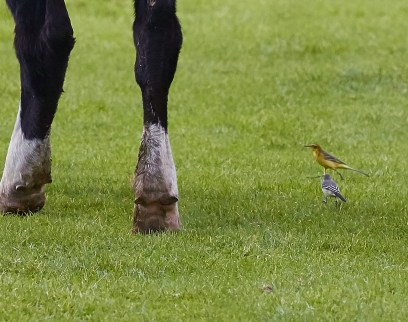
Butterflies seen were
several small whites, small heaths speckled wood and
comma. Flowers included lots of bristly ox-tongue,
hawkweeds, ragwort, fleabane, black medick, red
bartsia, red and white clover, yarrow, spear and
creeping thistles. The rock samphire along the sea
wall and glasswort by the water were at their most
colourful.
SATURDAY
SEPTEMBER 9 - 2017 - Havant Thicket
Heather Mills
reported on this morning walk by the Havant Wildlife
Group
Eleven met up this
morning with a lovely change in the weather boding
well for a stroll around Havant Thicket. Nuthatch was
one of the first birds to be heard from the car
park.
We took the main route out of the car park turning
north and following the extremity of the woodland.
Some of our group had not been before and were
surprised to learn that Nightjars and Woodcock make an
appearance, together with Glow-worms and plenty of
butterflies throughout the summer. Today we tried to
identify a couple of the fungi. Without our
knowledgeable Jim and Rosie, it was hard going. We did
agree on a False Chanterelle and Birch Polypore. The
birds were definitely in hiding for most of the
morning. Robins and Jays were heard easily enough but
the latter not seen. Some did catch up with two
fleeting glimpses of male Bullfinch as they flew over
us. Coal Tits were heard high in the Scots pine and
eventually we caught up with one poor speciman that
surprised us being on the woodland floor. We soon
gathered that this bird had a problem with it's
primary feathers. The wing being misformed and so the
bird constantly preened to try and straighten the tip
of the wing for flight, without success. Ros pointed
out the types of Heather with Cross leaved Heath and
Devilsbit Scabious showing well. Tormentil, Fleabane
and Hemp Agrimony were abundant along the sides of the
pathways and Ros also found a small patch of
Golden-rod. We were not so sure which type of Mint was
very abundant, possibly a Water type.
We saw two types of dragonfly Hawkers, Southern and
Migrant. Meadow Brown, Speckled Wood, Red Admiral,
Large White and a fresh Peacock also seen along with a
Hornet and large Hoverfly not identified.
A female Roe deer made an appearance as we
returned.
Southern Hawker
and Migrant Hawker
SATURDAY
SEPTEMBER 2 - 2017 - Testwood Lakes
Valerie Mitchell
reported on this morning's walk by the Havant Wildlife
Group
"First Saturday in
Autumn, and 10 of us met at Testwood lakes in glorious
sunshine, after a brief history of the lakes and
mention of the Middle Bronze age (1,500 BC) bridge
found when excavating, we went around the Little
Testwood Lake, then along South side of Testwood Lake,
after coffee we visited the visitor centre (only open
10-12 on 1st Sat. of month due to lack of volunteers).
There is a very attractive water efficient garden
here, with plenty of butterflies and insects. We then
headed North to Meadow Lake, the Sand Martin hide and
very successful sand martin wall (plenty of sand
martins were here 5 weeks ago), and then to the Heron
Hide where 13 herons were seen, 5 of which gave us an
aerial dance display. On leaving the Hides we retraced
our steps and went along the North side of Testwood
Lake back to our cars.
It was good to see
many trees laden with berries, nuts and acorns, and
plenty of thistles and plants laden seeds ready for
the birds winter feeding. We saw plenty today, so I'll
just list 'our specials'.
Birds included Cetti's Warbler, greenshank, sand
martins, great crested grebes, lapwings, TWO
kingfishers, tree creeper, white throat, Mistle thrush
along with starlings, eating the ripe elderberries and
blackberries in the sunshine, nuthatch, cormorants,
spotted fly catchers.
Numerous insects included ruddy darter, migrant
hawker, speckle wood, red admiral, comma, small
copper, whirly gig beetle.
Plants included angelica, orange balsam (apparently
non invasive), plenty of purple loosestrife,
honeysuckle, water dock, water mint.
We spent a very enjoyable four and a half hours here
and look forward to returning sometime.
Mystery
caterpillar is Red Admiral
Andrew Brown
came to the rescue to identify the mystery
caterpillar. The larvae is a pale form of Red Admiral.
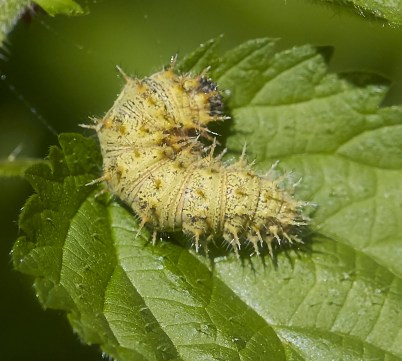
The caterpillar
feeds on Common Nettle leaves and lives hidden in a
tent of one or several leaves folded over and fastened
together by silk. No wonder I have never seen one!
When fully grown it is plump, spiny and very variable
in colour from light to dark. The chrysalis hangs
suspended inside the caterpillar's last tent. The
emerging adult feeds and flies around. Most perish in
winter, but some manage to survive and can be seen
fluttering around on warm days in mid winter.
SATURDAY
AUGUST 19 - 2017 - Old Winchester Hill
Jean reported
on this morning's walk.
This morning 8 of us set out to walk round Old
Winchester Hill. Before we left the car park, 2 female
black caps were spotted. There was also a Red Admiral
butterfly on the elder berries. Other birds seen were
a pair of jackdaws, ravens and kestrels. We heard a
green wood pecker correctly predicting wet weather.
Other butterflies seen were common blues, speckled
wood and meadow browns.
Flowers worth noting were a carmine thistle, yellow
wort, agrimony, wild parsnip, rest harrow, shiny
leaved black bryony with green berries, white bryony
with red berries, rest harrow, wild clematis, a few
round headed rampions, eye bright, Autumn gentians
and, unusually, a white knapweed. Small swathes of
hair bells were enjoyed.
Juniper berries were tasted, Thank you once again to
Ros and others for their fount of
knowledge.
SATURDAY
AUGUST 12 - 2017 - Magdelen Down
Tony Wootton
reported on this morning's walk by the Havant Wildlife
Group
6 of us met on a slightly overcast and occasionally
drizzly morning to walk over one of Butterfly
Conservation sites.
But it soon warmed up and we had some bursts of warm
sunshine. Our reward was large whites, brimstones,
small whites, meadow browns, gatekeepers, red
admirals, fresh small tortoiseshells, common blues,
chalkhill blues and a holly blue. Plus a Mother
Shipton and and several Pyrausta Purpuralis.
Flowering plants identified by us and certified by Ros
included comfrey, marjoram,yarrow, red bartsia,field
scabious, tufted fetch, creeping thistle, birdsfoot
trefoil,black meddick, white campion, black
hoarhound,meadow vetching,greater knapweed, hedge
bedstraw,rosebay willowherb, St John's wort,goats
beard,knapweed broomrape, wild basil, eyebright, wild
carrot, dew berries,rock rose, wayfarers,wild parsnip,
harebell, mellilock, field speedwell,
agrimony,mignonette,musk mallow,clustered
bellflower,sainfroin,dark mullian,kidney vetch, autumn
gentian, scarlet pimpernel, meadow cranesbill, field
poppy and lesser burdock.
Unsurprisingly birds were few and far between, but we
heard a green woodpecker, and saw a great spotted
woodpecker, goldfinch, 3 kestrels and quite a surprise
2 ravens.
Underneath 3 corrugated sheets I would like to say we
found a boa constrictor but we saw precisely
nothing.
SATURDAY
AUGUST 5 - 2017 - Wild grounds Reserve, Gosport
Tony Wootton
reported on this morning's walk by the Havant Wildlife
Group
9 of us went to this reserve this morning on which I
think is the groups first ever visit. The weather was
lovely, warm but not too hot with a nice fresh breeze.
Except we got a good soaking from an unexpected heavy
shower right at the end.
This is not a detailed report because we saw little of
anything different or unusual. The half of the reserve
we covered is heavily wooded, mainly old oaks some of
which were pollarded which is unusual for oaks. One
lovely large rowan heavily laden with berries. Made
some of us think of Gwynne Johnson.
We did see a large mixed flock of tits, a jay,
buzzards, green and great woodpeckers. Lesser
Woodpeckers are reported to be there, so perhaps
another visit next Spring. Heather heard a chiffchaff
and a kingfisher was also heard on the lake.
Other sightings include, clear winged hornet, roe
deer, water vole droppings, numerous unidentified
dragonflies, broad bodied chaser, common darter,
fringed leaf waterlilies, watermint, purple and yellow
loosestrife.
I think a Spring visit would be warranted when less
leaves would reveal more birds and woodland
flowers.
SATURDAY
JULY 22 - 2017 - Broadmarsh
Fay Durant
reports on Saturday's walk by the Havant Wildlife
Group.
Saturday dawned bright
and sunny , much to my surprise and remained
relatively dry until midday so we were very lucky .
Nine of us met up at the slipway car park ,
Brockhampton . We walked round either side of the
Hermitage and Brockhampton streams to the Budds farm
pools , including the stretch along Harts Farm Way ,
which is unavoidable . We returned along the coastal
path and then retraced our steps .
We saw a great variety
of flowers but the high light of the morning , as seen
in Derek's photographs , were the common
sandpipers . We had great views on both sides of
the water and much time was spent observing them .

We also saw
spectacular displays of starlings , in great numbers ,
along the coast . Also wonderful views of goldfinch
along the lower section of South Moor Lane , they were
everywhere . Three herons flew over , probably from
Budd' s pools . We were pleased to see a gadwall with
two duckling on the pools plus a number of dab chicks
, the inevitable coots , little egret , tufted ducks
and mallards . Other birds seen and heard : herring
gulls plus young , black headed plus young ,great
black backed , lesser , whimbrels , redshank ,
oystercatchers , turnstones . Also swallows , house
martins , a kestrel , sparrow hawk , long tails and
the song of blackcap and wren , plus blackbirds and
blue tits .
A vast list of flowers
but , probably the most striking is the bright blue of
chicory , on Budd's farm mound .

Others of interest :
stone parsley ,vervain , mullein , mugwort ,black
horehound , wild Arun , field madder , small burdock ,
teasels , bristly oxtongue ,hawkweed oxtongue ,
fleabane , white campion , perennial sow thistle ,
nipplewort , greater plantain and burnet rose . Plenty
of cherry plumbs on the ground and sloes on the
blackthorn . Many of us enjoyed tasting the
blackberries ! A few butterflies : small white , red
admiral , gate keeper and speckled wood .A very
rewarding morning .
SATURDAY
JULY 22 - 2017 - Stansted Forest
Steph Dale
reported on this morning's walk by the Havant Wildlife
Group
Thank you to the 5 who bravely joined me at the Sling,
Stansted today despite the forecast for rain later. We
walked along the footpath in the field above Finchdean
Road in relative dry (even sun for some of the time)
but then it got decidedly wet! We stopped to have
coffee and sheltered under some trees and then walked
back through the forest.
We did see a good
assortment of flowers in the field; many of these were
relatively stunted due to recent grazing by sheep.
They were hedge and ladies bedstraw, hogweed, meadow
vetchling, wild basil, agrimony, yarrow, field and
small scabious, birdsfoot trefoil, wild marjoram,
eyebright, red bartsia, St John's wort, crosswort (no
flowers), white clover, black knapweed, self-heal, ox
eye daisy, dark mullein, old man's beard, common
ragwort, lesser hawkbit, purging or fairy flax,
mignonette, dovesfoot cranesbill and teasels. We saw
four different thistles - creeping, spear, great marsh
and musk.
Musk
Thistle
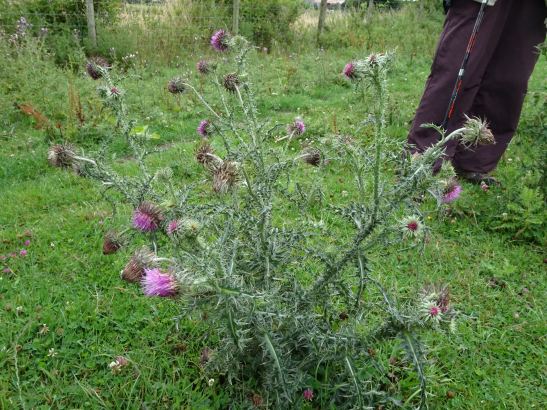
In the woods, we saw
upright hedge parsley, herb Bennett, water pepper,
hemp agrimony, lesser burdock and enchanters
nightshade. We heard a yellowhammer and a skylark and
we enjoyed watching stonechats in the nearby
barleyfield and sparrows in the hedges.
We had 3 sightings of roe deer in the valley and I
think it was generally agreed that 2 of these were the
same animal so we probably saw 2 roe deer in
total!
Insects seen were gatekeepers, meadow brown, ladybirds
and soldier beetles.
Afterwards we were invited to Val and Dave's for
coffee and also delicious homemade quiche and
chocolate cake! Thank you for cooking for us, Val, and
sorry you were unable to join us for the
walk.
SATURDAY
JULY 15 - 2017 - Brook
Meadow
Brian reported
on this morning's walk through Brook Meadow,
Emsworth.
This morning 11 members of the Havant Wildlife Group
(including me as leader) assembled in Bridge Road car
park Emsworth for the annual walk through Brook
Meadow. It was good to meet up with old friends and
new members who have joined since last time. Thanks to
Caroline for taking the photo.

I have not attended
the walks for some years, but they are still going
strong under the leadership of Heather Mills. I always
publish the walk reports on the web site. Details of
the group which was originally started by Ralph
Hollins in 1995 can be seen on the dedicated pages at
. . .
Railway
Wayside
Before going to Brook Meadow (as I revealed in
yesterday's blog) I had a little treat for the group.
We did a slight detour to visit the wayside behind
Emsworth Railway Station which currently hosts a fine
display of wild flowers. I think most members of the
group (apart from Caroline French) did not know the
wayside existed, so this was an eye-opener for them.
We walked up and down the access ramp at the rear of
the station from where the wayside could be viewed
easily. Young Caroline was agile enough to climb
through the fence onto the embankment to check out
individual plants. Here are some of the group on the
raamp looking at the wayside. Sorry my camera was on
the wrong setting for this photo.

We paid particular
attention to the Marsh Woundwort flowers which
are the best anywhere in the local area. With the help
of Ros Norton we confirmed the identification of
Upright Hedge-parsley.
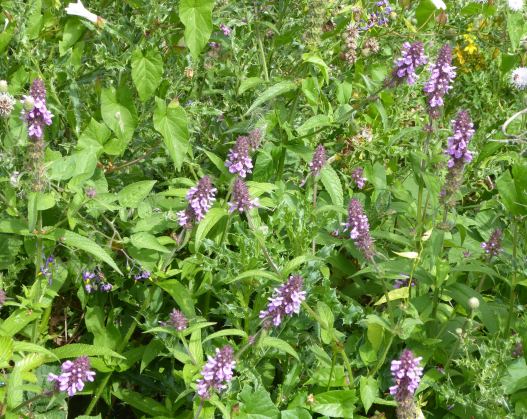
Brook
Meadow
Entering Brook Meadow through the Seagull Lane
gate we stopped to study the superb painting for the
interpretation board.

We also examined the
galls on the larger of the planted Oak trees and with
the help of Heather identified them as spangle and
marble galls. There were also other galls which we
were not sure about. We also looked at the other
smaller Oaks that were planted as saplings in 2012.
From the north bridge
we walked down the new ramp onto the meadow. Several
members sampled the aroma from the Meadowsweet.
Heather's sharp eyes
spotted a dead Ringlet in the vegetation near
the Lumley area, though some live ones were seen
later. (My photo below). We also came across lots of
Meadow Grasshoppers jumping around in the grass
(photo by Malcolm Phillips a couple of years ago).
At the Lumley entrance
we stopped to examine the plants in 'the Lumley
puddle' (now quite dry), including the tiny but robust
Toad Rush which Caroline held up for others to
see.
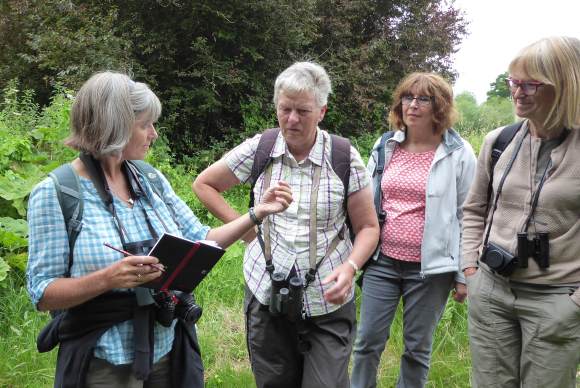
Heather spotted a Song
Thrush in the red leaved Cherry Plum tree on the
causeway, which I think Fay and others are looking
for.
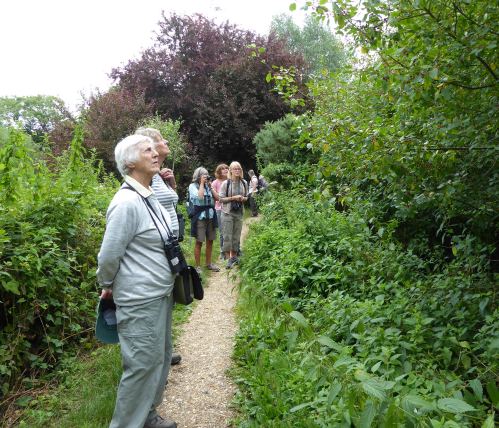
We did, in fact, get a
much better view of a Song Thrush and a young
Robin near the south gate. Photos by Derek.
Heather tried to make
friends with the Robin.
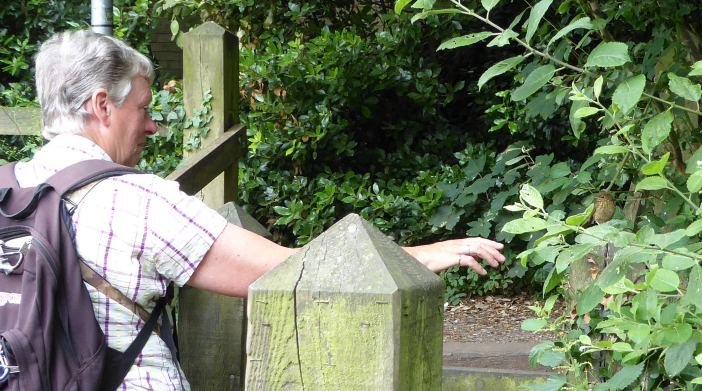
We stopped at the main
seat overlooking the meadow for coffee break. It just
so happened that Debbie Robinson (the group's
secretary) was set up there with sun shade and table
conducting a visitor survey. Debbie was delighted to
collect several £3 subscriptions from some people
who were not members which will help towards
maintaining the meadow in good order.
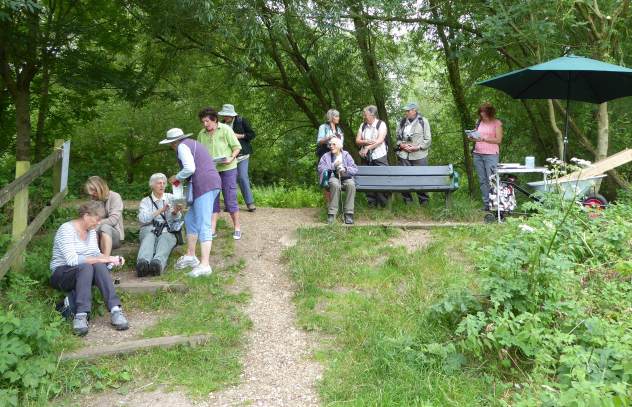
After the break we
walked down the new path by the Gooseberry Cottage
bund where we came across several
Bush-crickets. My photos were hopeless, but
Derek got a good one.
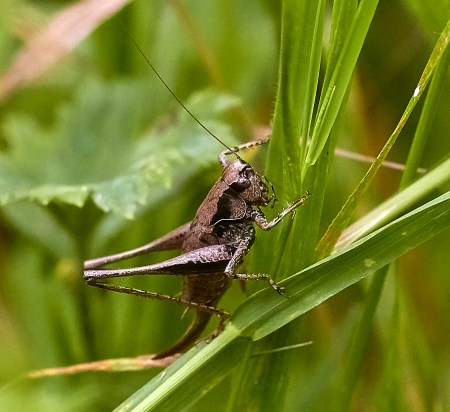
On the way back we met
David Search who had taken over the visitor survey
from Debbie. As David is our resident insect expert,
we consulted him about the Bush-crickets. He was not
sure at the time, but confirmed later that it was a
Dark Bush-cricket. David said something about
examining the genitalia which so shocked us, that we
all beat a hasty retreat!
David did have some
very interesting and surprising news that he had seen
two Kingfishers fly across the meadow while he
was on the seat. Wow! We were all very envious.
Kingfishers in summer are very rare in this area
(though common in winter). These may have been
youngsters dispersing from early broods further up
river.
Coming back along the main path we got a good view of
a male Beautiful Demoiselle by the river, which
had looked for but missed at the south bridge. My
photo.
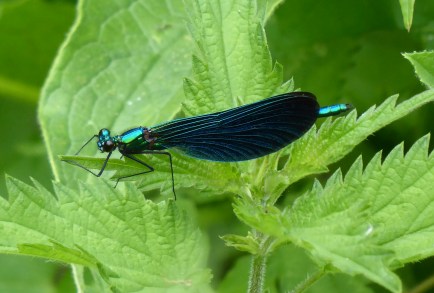
PS I have just
received the results of the visitor survey: 186
adults, 17 children, and 87 dogs went through the
meadow between 10am and 5pm.
SATURDAY
JULY 8, 2017 - Portsdown Hill
Ros Norton
reported on the Havant Wildlife Group walk
Today a group of 8 visited Portsdown Hill , West of
Churchillian as far as roundabout starting behind Fort
Widley and returning on south side of hill on a warm
and sunny morning with little wind.
We saw many butterflies, mostly gatekeepers and meadow
browns, some marbled whites, a brimstone, speckled
wood, red admiral, whites, and a few common blues.
Other insects included burnet moths, bumble bees,
soldier beetles, ladybird, grasshoppers and black
fly.
We also saw a possible
Essex skipper. Brian's note: Your Essex Skipper looks
good - with black clubbed antennae
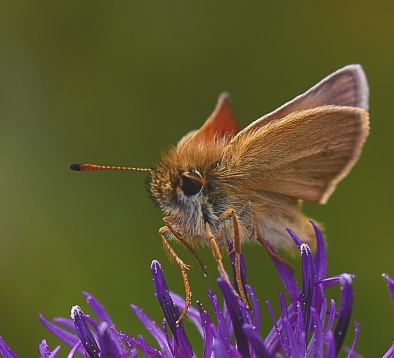
Birds seen and / or
heard were buzzard, swallows, house martins,
yellowhammer, linnet, greenfinch, goldfinch, blackcap,
stock dove, chiffchaff, whitethroat, wood pigeons,
magpies, jackdaws and crows.
The flowers were
amazing in variety and quantity. Pyramidal orchids
were still in flower. Knapweed broomrape had a good
year. Other highlights included lesser centaury, musk
mallow, mouse-ear hawkweed, bristly ox-tongue,
hawkweed oxtongue, perennial sow thistle, wild
marjoram, wild basil, field scabious, small scabious,
Lucerne, mellilot, tufted vetch, kidney vetch,
yellow-wort, St. Johns wort, rosebay willowherb,
squinancywort, fairy flax, eyebright, flax, spear
thistle, creeping thistle, fleabane, wild parsnip, red
bartsia, rest harrow, yellow rattle, travellers joy,
hedge bedstraw, ladies bedstraw, agrimony, hemp
agrimony, greater knapweed, black knapweed, yarrow,
common toadflax, common poppy, nettle leaved
bellflower, weld and mignonette. The hill was ablaze
with colours and flowers at their peak.
Lesser
Centuary
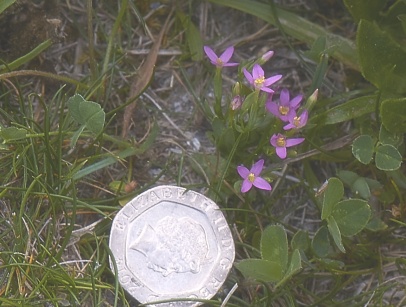
SATURDAY
JULY 1, 2017 - NOAR HILL
Helen Penfold
reported:
Eight of us had a lovely walk yesterday around the
flower filled chalk pits of Noar Hill, very ably led
by Nigel, who shared his great knowledge and
enthusiasm for the local orchids.
We saw and heard a yellow hammer, before we even left
the road, and saw several more along the way. We were
accompanied much of the morning by the song of song
thrushes chiffchaffs and chaffinches , but only got
occasional brief sightings of them. We also saw
buzzards, a kestrel and a few swifts.
The flowers were wonderful, particularly the pyramidal
orchids which were everywhere. We also saw common
spotted, fragrant, frog and lots of musk orchids, and
somewhat gone over twayblades and a bee orchid.
Other flowers seen included rest harrow, birds foot
trefoil, kidney vetch, black medick, tufted vetch,
pink and white clover, ox eye daisies, agrimony, hemp
agrimony, hog weed, wild parsley, hedge bedstraw ,
ladies bedstraw, self heal, yellow rattle, wild
marjoram and wild thyme, wild clematis, meadow
buttercup, small and meadow scabious, greater
knapweed, knapweed broom rape, cat's ear, mouse eared
hawkweed, hairy St John's wort, fairy flax, hare bell,
yellow -wort, eyebright, milkwort, clustered bell
flower, rock rose, ragwort, willow herb, juniper, the
seed heads of goatsbeard and more.
Butterflies seen included lots of marbled whites,
several skippers, meadow browns, ringlets (positively
identified by the rings on the under wings), small
heath and a silver washed fritillary.
Steph and I had a to leave after coffee, so it maybe
that lots more was seen after we left.
A lovely morning. Thank you Nigel.
SATURDAY
JUNE 24th 2017 - Milton Common
Fay Durant
reported Havant Wildlife Group walk
Six of us met up at Moorings Way , Milton, on a grey ,
damp morning. We walked along the bus lane to the
small nature reserve, over looking Eastney Lake . We
then made our way to the mouth of the canal , then
along the coastal path to the People's Memorial,
returning on a path the other side of the lakes. There
was little to see in the harbour apart from gulls ,
swans and a little egret .
The most interesting aspect was the wild flowers . The
contractors working on the sea defences had thrown
down wild flower seeds and for the first time we saw
corn cockle , corn marigold and the deep blue of
cornflowers among numerous clumps of mayweed , the
blue amidst the white making a stunning picture . A
list of other flowers seen : marrow , great bindweed ,
field bindweed , smooth sow thistle , bristly oxtongue
, meadow vetchling , birds foot trefoil , common
ragwort , creeping thistle , slender thistle , spear
thistle , fennel , sea radish - white and yellow ,
black knapweed , black horehound , red dead nettle ,
great willow herb , wild carrot , hemlock , hogweed ,
hoary cress , hedge mustard , woody nightshade etc !
Where would we be without Ros with Davids help ?
On the lakes we saw coot with young : baby and
juvenile - interesting to compare the two . Also
moorhen , tufted , mallard , little grebe and swans
with two fluffy grey cygnets . Dipping and diving
above us were House martins , making a delightful
display .We mainly heard black cap , green finch ,
dunnock , wren , with sightings of gold finch , great
tits , black bird , crows , sparrows and starlings
.The rain did ease off and three brave souls made it
to the end - well done ! Thanks to everyone for
turning up
SATURDAY
JUNE 11th 2017 - Langstone
Jean reported
on this morning's walk by the Havant Wildlife
Group
Eight of us set out on a lovely sunny morning from The
Ship Car park. We crossed the road to view waders
which included shellduck, redshank, oystercatcher a
Brent goose and a curlew. The flowers we saw were
hedge bedstraw, Lady's bedstraw, black knapweed which
had a six spot burnet moth feeding on it, yellow toad
flax, sea buck thorn, mallow, field scabious,
cinquefoil, sea beet. White dead nettle was seen
later.
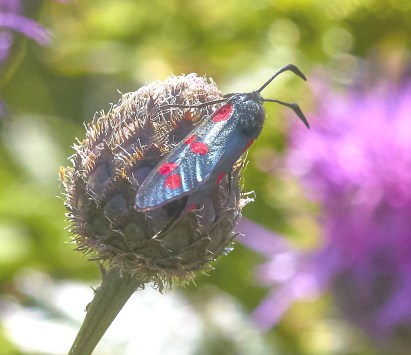
Brian's note: I can
only see 5 spots on the Burnet Moth, but Heather says
the outer two spots can fuse.
Crossing back to the
car park, we made our way towards the windmill, noting
the ivy leaved toad flax in the flint wall. At the
windmill we took the narrow path inland to the field,
where we saw field buttercup and dock. Elder flower
trees were flourishing. A song thrush was heard close
by. A pair of Meadow Brown butterflies and a white
were enjoying the sun. Following the stream on our
right, we saw nipplewort and many birds flying to and
fro too quick to identify. Two wood pigeons were on
the wires above us and a collared dove was heard. On
the ground we saw a young speckled robin A wren was
seen and heard - a blackcap heard. A green woodpecker
landed in the field where we had our first view of the
little egrets nesting.
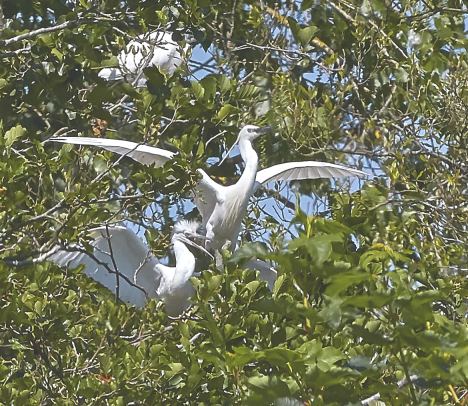
A heron was also
nesting. From the coastal path we had good views of
the little egrets panting as it was so hot. We had
close views of young swallows being fed by their
parents and a reed warbler singing.

In the pond were a
pair of swans, mallards, a tufted duck, coots and a
moor hen. A young heron was learning how to fish,
picking up a stick! Fay spotted a damselfly. Many
thanks are due to Heather and Ros for their
knowledgeable input.
SATURDAY
JUNE 10th 2017 - Portsdown Hill
east
Ros Norton
reported on yesterday's walk by 8 friends of wildlife
joined by one more later. They met in car park south
of George Inn, Portsdown Hill on a sunny but windy
morning and walked east towards Fort Purbrook
area.
"We
saw many insects including several small blue
butterflies, meadow browns, a large skipper, large
white and a cinnabar moth. On flowers were several.
male swollen thigh beetles (Oedemera nobilis). Some
grasshoppers, crickets and a female broad bodied
chaser dragonfly were seen.
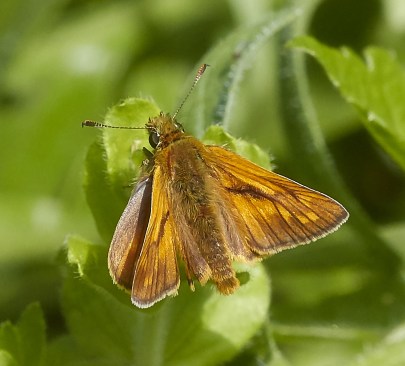
Birds
included jackdaws, robins, a rock dove, a buzzard,
jay, song thrush, blackbirds, swifts, swallows, wood
pigeons, wrens, black headed gulls and 2 adult
kestrels flying with young in the fort.
Highlights
among the flowers were the many pyramidal orchids near
the fort.

There
were also some common spotted orchids and a bee
orchid. Other flowers included common gromwell,
aquilegia, mouse-ear hawkweed, rough hawkbit, creeping
cinquefoil, sainfoin, vipers bugloss, red valerian,
wild carrot, rockrose, marjoram, dogwood, hedge
bedstraw, cleavers, bladder campion, milkwort, self
heal, rosebay willowherb, birds foot trefoil, black
medick, greater and black knapweed, dog rose, tufted
vetch, thyme, crosswort, agrimony, hemp agrimony,
yellow wort, quaking grass, flax, smooth sow thistle,
herb bennet, yarrow, white bryony, meadow vetchling,
woody nightshade, knapweed broomrape, mignonette, rest
harrow and bramble.
SATURDAY
JUNE 3rd 2017 - Chichester Marina and canal
Steph Dale
reports on the Havant Wildlife Group walk
Saturday 3 June was a
lovely bright sunny breezy day and ten of us met up at
Chichester Marina to enjoy a walk around the north
side of the marina and also along the nearby canal. We
saw a lot of birds with young including coots,
moorhens, swans and blue tits.
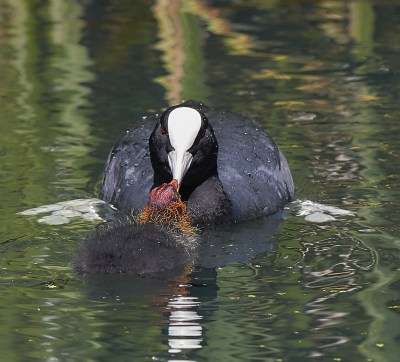
In the vicinity of the
marina we also saw 3 roe deer, cormorant, heron,
tufted ducks, shelduck, Cetti's warbler, pheasants,
pied wagtail, reed bunting, swallows, speckled wood
butterflies, red admiral, penny bun fungus, common
mallow, a southern marsh orchid and common spotted
orchid.
We saw a great variety of flowers along the canal
including yellow waterlily, yellow iris, red campion,
hedge woundwort, prickly sow thistle, sweet briar,
lesser calamint, creeping cinquefoil, hemlock water
dropwort, yarrow, spotted medick, ribwort plantain,
birdsfoot trefoil, buckthorn, germander speedwell, red
and white clover and hedgerow cranesbill. Then, having
passed it once without noticing it, we saw on our way
back, a beautiful specimen of a bee orchid.

During the coffee
break some of us enjoyed watching a reed warbler
dodging in and out of the reeds on the opposite
bank.
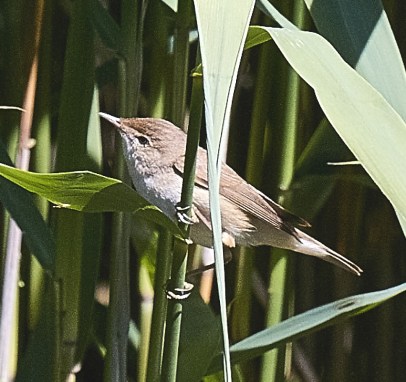
There were damsel
flies and dragonflies along the canal. Other birds
observed during the walk were buzzards, linnets,
kestrel, whitethroat, black cap, wren, swift, black
headed gull, male bullfinch. The calls of the greater
spotted woodpecker, lesser whitethroat, chiff chaff
and sedge warbler were heard. Thank you all for your
company and expertise,
SATURDAY
MAY 20th 2017 - South West Hayling
Ros Norton
reported on this morning's walk by the Havant Wildlife
Group
Today a group of 7 walked a circuit of West Hayling
from the Gun Site lay by clockwise via Gunner Point
and ferry on a day of mixed weather.

The masses of tree
lupins were spectacular as most had not been eaten by
aphids this year. Sea kale was equally spectacular but
we were too late for the green winged orchids. A few
plants of Nottingham catchfly were seen. Other flowers
included yellow horned poppies , sea sandwort, beaked
hawksbeard, mouse ear hawkweed, hoary cress, spring
beauty, tamarisk, hares tail grass, birdsfoot trefoil,
storksbill, spindle and thrift.
Several common blues, a white and a painted lady
braved the weather. Caterpillars of lackey moths, Oak
Eggar moths and possible white satin moths were
seen.
Birds seen or heard
included skylarks, whitethroats, blackcaps, chiff
chaffs, a mute swan, tufted ducks, linnets,
greenfinches, greater spotted woodpecker, greater
black backed gulls and long tailed tits.
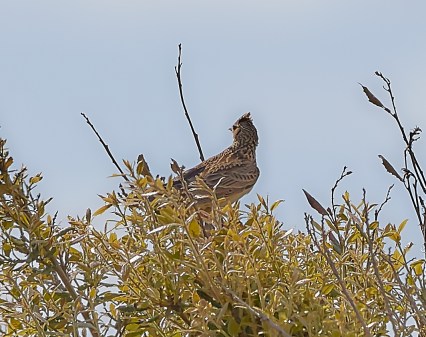
Our current walks
programme is near the end so we are having a meeting
at Ann's house, 52 Roman Way, Bedhampton on Monday 5th
June at 7pm for people who could lead a walk. If you
have a walk but cannot get to the meeting please send
details to Heather.
SATURDAY
MAY 13th - 2017 - Portchester Castle
Fay Durant
reported on yesterday's walk by the Havant Wildlife
Group
Seven of us met up in
the Portchester Castle car park for our Saturday
morning amble . The sky was overcast and we had a few
drops of rain but gradually conditions improved. The
water in the castle moat was very green, plus the
ditch along the sea wall but we did see a cormorant
fishing in the latter . We walked south , round the
castle walls , observing the wild wallflower plants ,
still showing flowers , growing in the castle walls
plus large patches of valerian . We caught sight of
swifts flying overhead and later swallows dipping and
diving under the bushes , delightful .
Along the sea shore were oystercatchers , a large
black backed gull and two whimbrels , well camouflaged
against the seaweed . Heather picked out a great
crested grebe out at sea and then a small flotilla
.
Other birds seen were sparrows flitting in and out of
bushes bordering the sea path , masses of crows ,
(Hitchcock ! ) starlings , greenfinch , dunnock ,
great spotted woodpecker ,Robin , blackbird , blue tit
, goldfinch , long-tailed tits and one whitethroat !
Wren , chiffchaff and blackcap were heard singing
.
We returned from the coastal path , up hospital lane
and across to the picnic benches for coffee , later
proceeding north , along the sea wall and back across
the grass . A good number of flowers were noted , with
the help of Ros , where would we be without her !
List : cow parsley ,rattle , red clover , buttercups :
creeping , field and bulbous , cleavers, oxeye daisies
, goats beard , common vetch ,black medic , beaked
hawksbeard , birdsfoot trefoil , Portsmouth weed ,
alexanders , smooth sow thistle , bladder campion,
white comfrey ,green alkanet , herb Robert , herb
bennet and one bright blue flower of chicory . David
discovered a large clump of horseradish , close to the
picnic benches , quite tall with dock- like leaves and
small white flowers on long stalks .
Few butterflies : a speckled wood , a white and
possibly a red admiral .
A productive walk , much enjoyed .
SATURDAY
APRIL 29 - 2017 - Heath Pond, Petersfield
Valerie
Mitchell reported on this morning's walk by the Havant
Wildlife Group.
A group of 7 met at
Petersfield Heath Pond Car Park on a sunny morning. We
explored the heath & woodland before walking
around the pond, although we could hear the birds in
the trees, with all their fresh green foliage, we saw
only a wren, long tail tits, robin, blackbirds,
magpies, hedge sparrows.
On the pond we saw a pair of Egyptian geese looking
after their one gosling, while the mallards had 5
ducklings, several Canada geese, coots, crested grebe
and black headed gulls. We had a brief glimpse of a
few sand/house martins in flight, a holly blue, a
common green capsid and a red admiral.
We turned our attention to the many plants &
flowers, Jack in the hedge, alkanet, creeping
buttercup and other types, plantains, heathers,
greater stitchwort, honesty, white dead nettle, wood
avens, cleavers, red campion and large bittercress. We
admired the fresh growth on spruce and larch.
Dave found the remains of an old hornet 's nest near a
dead old silver birch tree.
It was an enjoyable, very warm, leisurely walk,
despite so many families & dogs coming out to
enjoy the sunshine !
SATURDAY
APRIL 29 - 2017 - Farlington Marshes
Heather Mills
reported on this morning's walk by the Havant Wildlife
Group. Photos by Derek.
"Although it was a
very cold and dull start to this morning's walk,
eleven enjoyed the variety of birds to be seen on
Farlington. We began in the car park listening to a
Common Whitethroat on the Elder. Soon onto the reserve
we had a Song Thrush and Blackcap. The latter keeping
well out of sight but the song unmistakable. Dave
spotted a Crow nearby and after getting the scope onto
it, found it to be tucking into a large frog, which it
gathered up and flew off with. A pair of Tufted duck
swam on the pond and our first Wheatear out on the
shore gave us a brief close view when it flew onto the
sea wall. Singing Reed Bunting could be seen in it's
usual habitat in front of the reed bed. Two Dunlin in
summer plumage were avidly feeding on the lake and a
Greenshank visible here and on the mudbank to the
west.

Pairs of Med Gulls
"mewed" overhead. Tony spotted a lone Brent goose. A
visitor told us that there were still two Short Eared
Owls present and so we made haste to the point. As we
took a coffee break we encountered a Little Tern
flying on the edge of the incoming tide. A Sandwich
Tern was seen much later. The cold Southerly wind kept
the Owl out of sight until we turned the point to go
North. It was hunkered down inside the barbed wire
fence, enjoying a leisurely preen.

A close Sedge warbler
gave good views along with several male Linnets. As we
got to the lake five Avocets were to be seen. One
stayed motionless on a little mud isle-let, hopefully
nesting. A pair of Wigeon seemed quite at home along
with Shoveler as we were alerted to squabbling
Redshanks by Fay. Skylarks pleasantly serenaded us
constantly it seemed the length of our
walk.
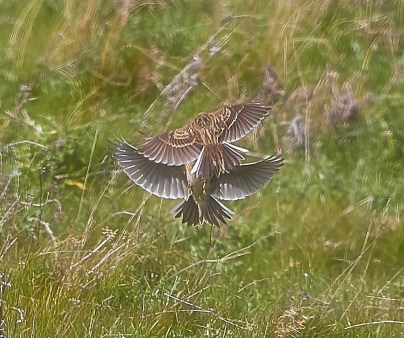
As we looked out to
sea, twelve Whimbrel flew to the edge of the incoming
tide. Some were able to hear their call and notice the
difference between that of the Curlew. We had been
told of a possible Nightingale on Peter's pond and so
most of us visited but we were not able to hear it. We
retraced our steps to the hut and heard the Reed
warbler and another Bunting. Some had heard the
Bearded Reedlings. Most noticeable by their absence
were the Black tailed Godwits.
A good morning made
even better by the warmth of the now visible sun as we
finished. One small white butterfly and an Orange Tip
seen. Plenty of Cow parsley, ground Ivy and Rape and
Wintercress, with Alexanders and a Chickweed. A large
Sea Kale grew out of the wall at the point.53 species
seen and 3 heard.
SATURDAY
APRIL 22- 2017 - Thorney Island
Ros Norton
reported on the Havant Wildlife Group walk
A group of 11 met for a walk from Thornham Lane
junction to Thorney Deeps (west). Much birdsong
greeted us including blackcap, willow warbler, sedge
and Cetti,s warblers, whitethroat, skylark, wren,
greenfinch and goldfinch. On the Little deeps wwas a
pair of gadwall and a little grebe. At the Great Deeps
we saw oystercatchers, lapwings, shelducks, a black
backed gull, redshanks, black headed gulls and a
nesting swan. Cormorants and swallows flew overhead.
Kestrel, buzzard , a pair of stonechats, mallards,
coots and moorhens were seen. In harbour feeding on an
outgoing tide were 2 greenshanks, oystercatchers and 2
well camouflaged whimbrels. We caught a glimpse of a
redstart near an abandoned farm.
Greenshank
colour-ringed G+LG
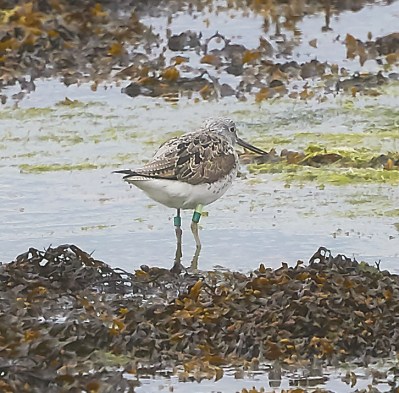
Herons nesting?
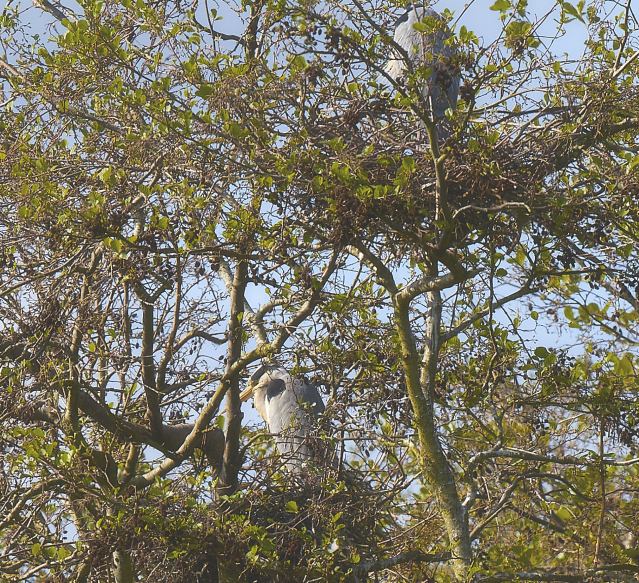
Flowers included
bluebells, cow parsley, coltsfoot, common vetch,
garlic mustard, ground ivy, bulbous buttercup and lots
of gorse. Some gorse had mystery webs that may contain
spider mites possibly. Other webs of browntail moth
caterpillars were on bramble bushes. A holly blue and
a green veined white butterfly were seen.
A bloody nosed beetle was seen at the Great Deeps and
we also saw mystery roundish dark, segmented insects
on hedge bedstraw nearby. Searching the internet we
found that they are the larvae of the bloody nosed
beetles.
SATURDAY
APRIL 8- 2017 - Baffins Pond
Fay Durant
reported on yesterday's Havant Wildlife Group
walk
Six of us met at the
recreational ground car park, adjacent to Baffins
pond, for our Saturday morning walk. We were soon
joined by a seventh, who had parked elsewhere. We
started in thick fog but it soon lifted and we were in
bright sunshine.
Walking through the small wood to the pond we saw
clumps of wild garlic, dotted with Spanish bluebells.
A very white fronted cormorant sat at the end of one
of the islands. Black headed gulls and young herring
gulls perched on the pond posts and we saw a female
mallard with thirteen very small ducklings, we did
wonder how many would survive. They were so
delightful.
Brian's
note: there were 11 ducklings on Baffins Pond on
Sunday. See the Emsworth blog at .
. Current
wildlife 'blog'
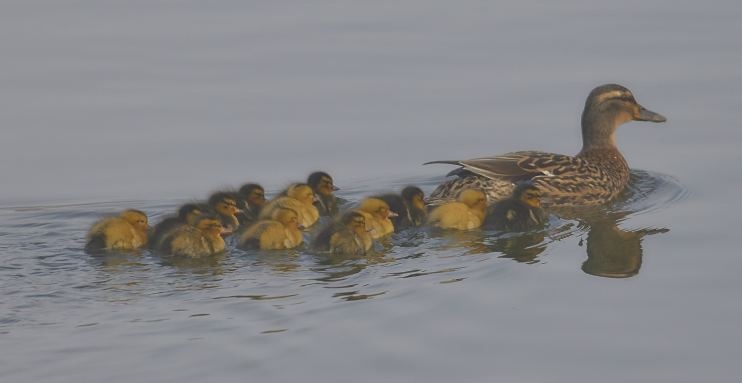
Helen then performed
her good deed for the day by rescuing an upside down
bumble bee from the water, using a willow frond,
before a coot could devour it! There were nice clumps
of king cups. Moorhens wandered along the bank and
there were tufted ducks everywhere - great to be able
to see them up close. There were less Canada's than
usual and one seemed to have paired with a white
goose. A wren serenaded us from a tree and kept
company with us.
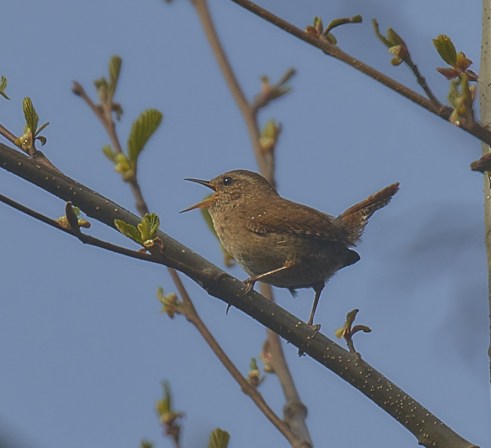
Heather then
identified blackcap and we then heard many more,
finally spotting one just before we left the green -
success! Later woodpeckers were seen flying .
We had a few problems identifying bushes and trees .
The alders were easy, with catkins and small cones
dangling. A row of flowering bushes we weren't so sure
about: cherry , plumb or pear ? Also a line of silvery
grey trees , a type of birch ?
Brian's
note: Heather sent me this photo
It looks like White Poplar from the catkins and colour
of leaves.
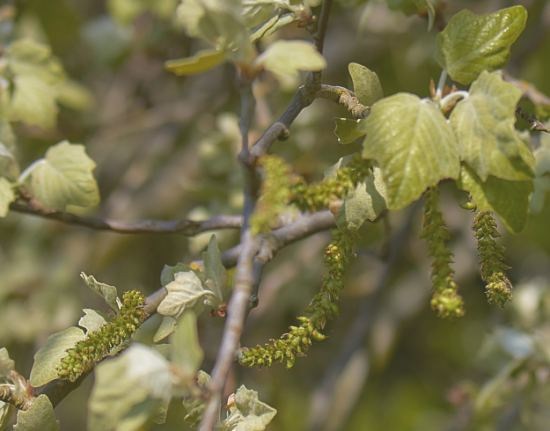
We walked up beside
the Baffins volunteers centre , as far as the Brent
geese field , across and east , beside the college and
across to the path beside Langstone Harbour .
We had coffee at the memorial . A swallow was seen
dipping and diving . Heather heard 2 Sandwich terns
calling . Many chiffchaffs were singing , plus
greenfinch and goldfinch . Cetti's song was very
noticeable then we saw one flying amongst the reeds ,
very satisfying! A couple of med gulls flew overhead
and a little grebe was seen on the lake.
Flowers seen : cow parsley , alexanders , charlock ,
Portsmouth weed , red campion , plenty of red dead
nettle , shepherds purse , gorse and a nice clump of
honesty .
Butterflies : several peacocks , small white ,
brimstone , small tortoiseshell and a speckled wood .
A perfect Saturday morning .
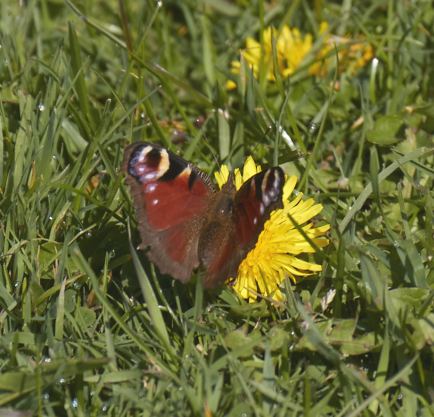
SATURDAY
APRIL 1- 2017 - Kingley Vale
Heather Mills
reports on this morning's walk by the Havant Wildlife
Group
9 met this morning for
a leisurely walk first through Stoke wood and on up to
Kingley Vale. It was a pleasure to welcome Nicola and
Peter who have moved to enjoy our wonderful coast.
This was a flower fest as well as enjoying the bird
song. An early view of a pair of Bullfinch and singing
Coal Tit gave a good start to the walk with a calling
Tawny Owl for added pleasure. The Bluebells were just
beginning their spectacle of colour. We had a
delightful view of Lesser Celandine with Wood anemones
and Moschatel or Townhall Clock as some know it. A
good patch of Early Dog violets livened up the walk
with colour. A few Sweet violets also. Cow parsley and
Herb Robert joined White and Red Dead nettle. Ros also
noted Hogweed and Charlock later.

Leaving Stoke wood
behind us we had good views of our first pair of
Yellowhammers. Coal, Great, and Blue tit, Goldcrest,
Robins, Wren, Blackcap, Chaffinch and Song Thrush all
singing with an occasional Green Woodpecker yaffle. As
we proceeded in an easterly direction towards Kingley
another Yellowhammer appeared on top of a bush. There
were several male Chaffinch in the sown field to our
right and we then noticed several Yellowhammers to our
left. As we looked in earnest I counted 18 in all.
Mostly they looked like males with one or two females.
A real highlight to see so many. A Brimstone also
darted out along the path as it warmed up. Later we
saw Peacock and Comma.

We ventured to the dew
pond and although it was very clouded up with mud, we
saw a few pond skaters and at least 3 newts. They did
not stay up long enough to ID. There were a few
tadpoles too. This area is now fenced with a partial
break to enter. There was evidence of cattle. Also a
new water butt was evident earlier on with a feed
crate for sheep.

On our return 2 more
Yellowhammers sat in the usual hedge separating the
fields on the west side, whilst a Buzzard flew
overhead. A very enjoyable morning.
Coffee break
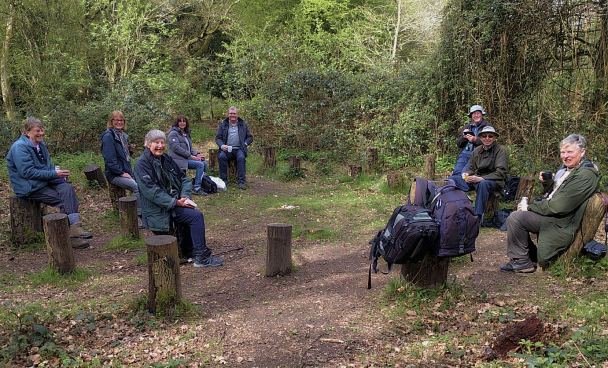
SATURDAY
MARCH 25 - 2017 - Alver
Valley, Gosport
Tony Wootton
reported on this morning's walk by the Havant Wildlife
Group. 11 had a lovely Spring walk this morning. Just
occasional blasts of a Northerly wind reminded us that
Winter hasn't quite gone yet.

We saw butchers broom,
ivy leaved speedwell, Alexanders, primrose, celandine,
and more coltsfolt than anyone can remember anytime
anywhere. Here are just some of them snapped by
Heather.
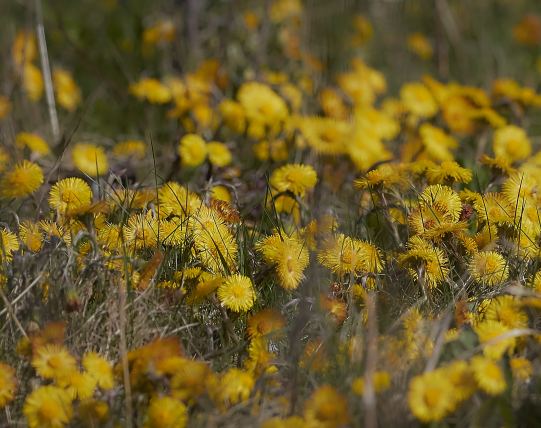
Both male and female
brimstones and 2 commas (does that make a full stop).
Numerous bees and a common lizard.
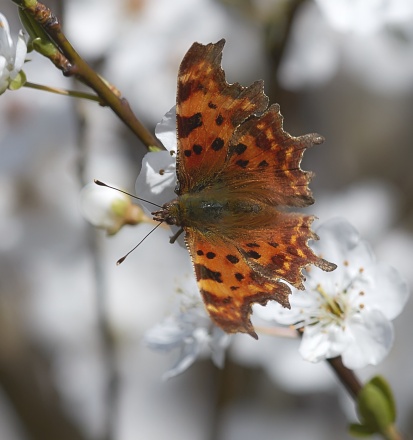
Birds included
mallard, moorhen, sparrowhawk, buzzard and kestrels
gave us a courting display. Stock dove, green
woodpecker, GS woodpecker, skylark, meadow pipit,
wren, dunnock, robin, blackbird, heard cetti's and
blackcap. Dartford warbler, chiffchaff, long tailed
tit, blue tit, great tit, treecreeper, jay, magpie,
carrion crow, greenfinch.
Ralph's
move
After 49 years and 8 months living in the same house
in Havant Ralph Hollins (the founder of the Havant
Wildlife Group) has moved into a flat near St Mary's
church on Hayling Island from where he will be able to
start his personal natural history of the island . For
his first entries after the move see his wildlife
diary at . . . http://ralph-hollins.net/Diary.htm
SATURDAY
MARCH 18 - 2017 - Hook with Warsash
Tony Wootton
reports on this morning's walk.
Just when you thought Spring was here , we were back
to a grey day again. Still it wasn't cold and the
Northerly wind wasn't too strong. We saw butchers
broom , field speedwell,coltsfoot, gorse, white
violets, sweet violets, primrose, celandine, vinca,
alexandra, pussy/goats willow, and chickweed.
We heard chiffchaff, cetti's, skylark and green
woodpecker.
We saw avocet, gadwall, pintail, teal, shelduck,
shoveler, brent, Canada, mallard, godwit, moorhen, Med
gull, herring gull, black headed, turnstone,
oystercatcher, curlew, dunnock, robin, great, blue and
longtail tits, song thrush, blackbird, starling,
linnet, stock dove, little egret, redshank, magpie and
meadow pipit.
We also saw 3 roe deer and a polar bear.
Finally, we had a very interesting chat with a coastal
ranger for Bird Aware Solent. This a partnership of
local councils and conservation bodies whose aim is to
educate the public on the importance of maintaining
peace and quiet for breeding birds. The rangers job,
as well as bird counts, was to approach and educate
any member of the public who he thought were
unsettling breeding birds.
Not a body that any of us had heard of. Their website
is http://www.birdaware.org/home
SATURDAY
MARCH 11 - 2017 - Huckswood Lane.
Tony Wootton reports:
The intrepid leader and his trusty sherpa set off into
the far North of Rowlands Castle into what I believe
the Scots call a dreich.
We were rewarded with blue tit, great tit,
chaffinch,song thrush, blackbird, magpie, wood pigeon,
robin, several skylarks singing,jay,jackdaw, carrion
crow, linnet, yellowhammer, house sparrow,starling and
Med gulls mewing overhead.
Flowering plants included (we think) white dead
nettle, red dead nettle, celandine, dog's
mercury,primrose, field speedwell, wood anemone,
bittercress, wood spurge and an unidentifable
wort.
SATURDAY
MARCH 4 - 2017 - Stansted Forest
Heather Mills reported
on the Havant Wildlife Group walk
Four met on a glorious spring morning filled with an
assortment of Stansted's birds singing. Robins were
the most prolific. Nuthatch, Goldcrest, Chaffinch and
most noticeably at least 3 Song Thrush in the vicinity
of the car park. As we slowly progressed along the
main thoroughfare towards the house we could hear
Great Spotted Woodpecker drumming. The Jackdaws were
vocal and a Stock dove called.
The grounds were busy with joggers and cyclists, so we
took a muddy footpath beside the main road. Here we
saw our first Redwing and had a very close encounter
with Dunnocks foraging under our feet as we progressed
eastward. In the gardens of Stansted were masses of
Primroses. The Highland cattle had 2 young calves.
Behind the first cottages we heard our first
Yellowhammers. I counted at least 4 along this stretch
starting their song, with one nearly completing the
"little bit of bread and no cheese". Here we had good
views of 4 Meadow Pipits and a singing Linnet. Dog's
Mercury was abundant but Celandine only seen at the
entrance to the gatehouse, where Snowdrops and a small
patch of Violets were evident. A small patch of Wood
Spurge seen. As we walked towards Walderton we kept a
lookout for the Green Hellebores which were in flower.

Although several
Bullfinch called along the way, we did not locate
them. A small party of Long-tailed Tits pecked for
insects as we turned north alongside the fields to
take the footpath back to the road. We came across 2
Marsh Tits along the hedgerow, whilst Coal Tit sang
and we caught a snippet of Skylarks singing, but not
for long. Beyond the 2 cottages in the past we have
been fortunate to see Fieldfare and Redwing. Today
only Redwing visible with about 20 foraging on the
ground around the trees.
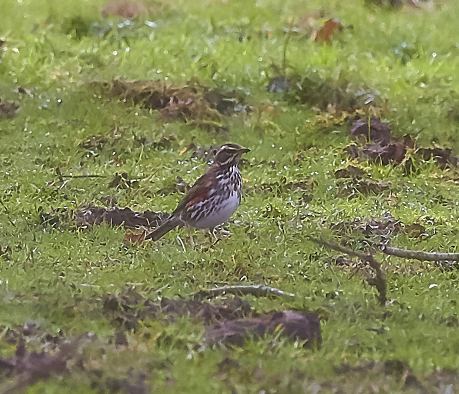
31 bird species seen.
A very pleasant outing.
SATURDAY
February 25 - 2017 - Pulborough Brooks
Ros Norton
reports on the Havant Wildlife Group walk
A group of 10 met at
RSPB nature Reserve at Pulborough Brooks on an
overcast day with a cold wind. We started at the
furthest viewpoint and hide, visiting them all before
having lunch in their café.
Many birds were on the water including wigeon, teal,
shelduck, shoveller and mallard. There were many
Canada geese and one greylag. some cormorants,
lapwings , mute swans, little egret and a heron. A
pair of stonechats were in vegetation in front of our
hide. Woodland birds included a bullfinch, a
treecreeper, greenfinch, a goldcrest , rooks, crows, a
song thrush and jays. Both green and greater spotted
woodpeckers were heard. Pied wagtails were in the
grass near the water and a snipe was hidden in the
reeds apart from its head. Raptors seen included a
marsh harrier, sparrowhawk, buzzard and
kestrel.
SATURDAY
February 18 - 2017 - Chichester Gravel Pits
Heather Mills
reported on this morning's walk by the Havant Wildlife
Group:
6 met this morning on a positively spring like morning
with Great Spotted Woodpeckers drumming in the
distance. We took our usual course onto the lakes from
North Mundham as Ros noted that a Long-tailed duck had
been reported. Blue and Great tits and Chaffinch song
filled the air. Long-tailed tits were very active in
the brambles immediately in front of us in Copse Lake,
with no fear of our presence. Pochard and Tufted ducks
with Great Crested Grebe gave good views with the
Greylags. It was then obvious that one of the Tufted
ducks was in fact a female Scaup. This was followed in
the next lake by a distinctive male. We looked for the
singing Cetti's warbler who showed well before
disappearing into the reeds. The Great Crested Grebes
gave a small inkling of their mating intention of
mimicking each other's moves. We slowly moved on and
tried a slightly different path overlooking West Trout
Lake, on the south. The usual Coots and Black headed
gulls were seen with Mallards. It was when we rejoined
the main path that Ros spotted the Long-tailed duck in
winter plumage, without the long tail. We all had good
views before it made itself scarce. Word soon got
around as more birders appeared looking for the
aforementioned birds.

After a leisurely
break, we retraced our steps noting the Common Gulls
and listened to the song of Goldcrests flitting along
the footpath.
A Chiffchaff appeared
with one of the Goldcrests, but it did not sing. One
of the birders reported that a Bittern had flown out,
much to our chagrin. We ended the walk going north
along "Steptoes yards", alongside Runcton Lake. The
spectacle of nesting Cormorants was worthy of note
with their white thigh patches and quite a few with
grey heads.

It was noticeable that
no Herons were seen. Although a couple of Little
Egrets sat in the bushes. Here a flock of Shovelers
took off to rest at the back of the lake. 41 species
seen on a warm sunny and eventful morning.
SATURDAY
February 11 - 2017 - Blashford Lakes
Tony Wootton
reported on this morning's walk by the Havant Wildlife
Group
It was a really cold grey morning today with
occasional flurries of sleety snow to contend with as
well as an icy wind blowing into some of the hides of
the lakes. Many thanks to the 9 members who braved it
all to support me.
As well as many lovely scarlet elf cups, we saw, mute
swan, canada goose, shelduck, wigeon, gadwall,
mallard, pintail, shoveler, pintail, tufted duck,
goldeneye, goosander, little grebe, great crested
grebe, cormorant, little egret, buzzard, coot,
lapwing, blackheaded gull, lesser blackbacked gull,
herring gull, wood pigeon, great spotted woodpecker,
wren, dunnock, robin, blackbird, song thrush, mistle
thrush, redwing, longtailed tit, blue tit, great tit,
marsh tit, nuthatch, jay, magpie, jackdaw, carrion
crow, chaffinch, brambling, greenfinch, goldfinch,
siskin, redpoll and reed bunting. 47 species in
all.
It is always lovely to be in the woodland hide and see
so many species in such numbers. Well done to the
rangers of HWT
SATURDAY
February 4 - 2017 - Southsea
Fay Durant
reported on the Havant Wildlife Group at Southsea.
Eight resilient people met on Saturday morning after a
day of strong winds and rain . Amazingly the day
started dry with no wind and then the sun broke
through and the sea was sparkling , quite a morning to
remember .
We met on the Eastern Esplanade and made our way to
the beach , round the pitch and put , where we watched
a herring gull attack a plastic bottle ! ( A large
group of gold finch were gathering in one of the trees
) .Much of the shingle on the beach had been washed
away or deposited on the prom and cycle path . We
examined the tide line where dead star fish were
scattered along its length . They were large and small
with great colour variation , from a delicate pink to
a much deeper colour . A fine selection of shells ,
including razor shells , whelks , cockles etc Also
cuttle fish , egg cases of whelk and two different
shaped purses , later identified by Ros as Mermaids
purses - the smaller one with tendrils was possibly a
dog fish egg case, and the other darker larger ones as
Ray.
A couple of sea
anemones were spotted one in good condition , plus sea
weed and other sea debris .After much examination of
the beach we walked through the rose gardens where
Robin , blue tit , numerous blackbirds , dunnock were
seen and heard.
We then circled the
Canoe Lake , full of swans at this time of year plus
various varieties of gulls . Back on the promenade we
examined the shore line again and then made our way to
Rocksbys for a welcome drink , stopping on the way to
admire Hilary's memorial bench where several group
photographs were taken .
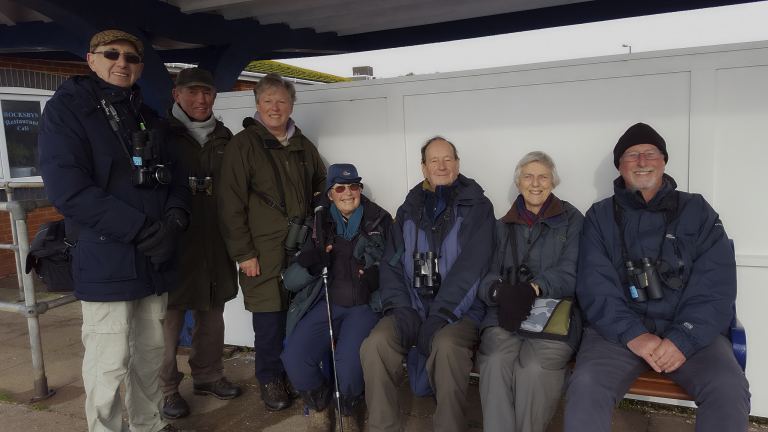
We finally made our
way to Southsea Castle , where the tide was suitably
low for us to view two very busy rock pipits feeding
and then , the high light of the walk , seven purple
sandpipers , running at great speed across the rocks ,
stopping now and then to forage .
We then returned by Brian Kidd Way , through the rock
gardens , admiring rosemary in full flower , probably
a special cultivated variety , along the prom and back
through the rose gardens . There were many herring
gulls along the shore line but none seem to be
interested in the star fish and we wondered why they
appear inedible ? A very pleasant winter morning
.
SATURDAY
JANUARY 28 - 2017 - Hayling Oysterbeds
Report by Ros
Norton
A group of up to 9 visited Hayling Oysterbeds on a
lovely sunny morning . There was a noticeable wind and
high tide was 11.44. We had a look from the car park
and saw some Brent geese, lapwing, turnstone, dunlin,
redshank and grey plover.
We then walked north along the Billy Line and saw 14
magpies together in trees. We heard several singing
greenfinches and saw blackbirds, a stonechat, linnets,
pied wagtails, a greenshank, redshank , kestrel and
some godwits.
During our coffee break we watched large flocks of
dunlin flying in for the high tide roost. Some saw a
kingfisher. There were some great crested grebes,
goldeneye ducks, mergansers and a group of 3 slavonian
or black necked grebes far out in Langstone harbour.
Nearer were wigeon , gadwall and little grebes .
Pipits flew by.
There was a very large number of birds on the
Oysterbed islands, bunds and spits. These included
groups of dunlin, oystercatchers, redshank, brent
geese, grey plovers, turnstones and a few ringed
plovers and curlew for the high tide roost.
SATURDAY
JANUARY 21 - 2017 - Hayling Billy Line
Report by Jean
Hildersley
On a frosty, sunny morning 3 of us set out to walk
along The Hayling Billy Line. In the car park, a wood
pigeon was in a tree, enjoying the sun. Several crows
flew over. In the hedge row area, numerous black birds
were seen and heard 'clucking' away in alarm, probably
because of the many dog walkers. Robins, wren, were
seen and heard. A great tit was heard and a flock of
brent geese flew over. When we reached the bay, we saw
oyster catcher, redshank, godwit, dunlin and shelduck.
Curlew and grey plover were heard. Seeing the red seed
pods of stinking iris led to much discussion. Walking
back to the car park gave us time for interesting
personal chat.
SATURDAY
JANUARY 7 - 2017 Titchfield Haven
Report by
Tony Wootton
9 of us met on a misty but amazingly mild (11
degrees) and still January morning. We only went up
the Eastern hides plus the spit of gravel on the far
side of the harbour. We saw on the walkway, great tit,
blue tit, longtailed tit, both goldcrest and
firecrest, jay, blackbird,wren, great spotted
woodpecker.
Then from the hides, blackheaded gull, common
gull,lesser
blackback,wigeon,gadwall,teal,curlew,blacktailed
godwit,magpie,pheasant,carrion crow,lapwing,shovelers,
moorhen,wood pigeon,shellduck,cormorant,little
grebe,heard water rail,buzzard, marsh
harrier,kingfisher.
Out on the spit,dunlin, oystercatchers and a lovely
female snow bunting came to look at us.
FOR
2016 WALKS REPORTS GO TO
.
. 2016